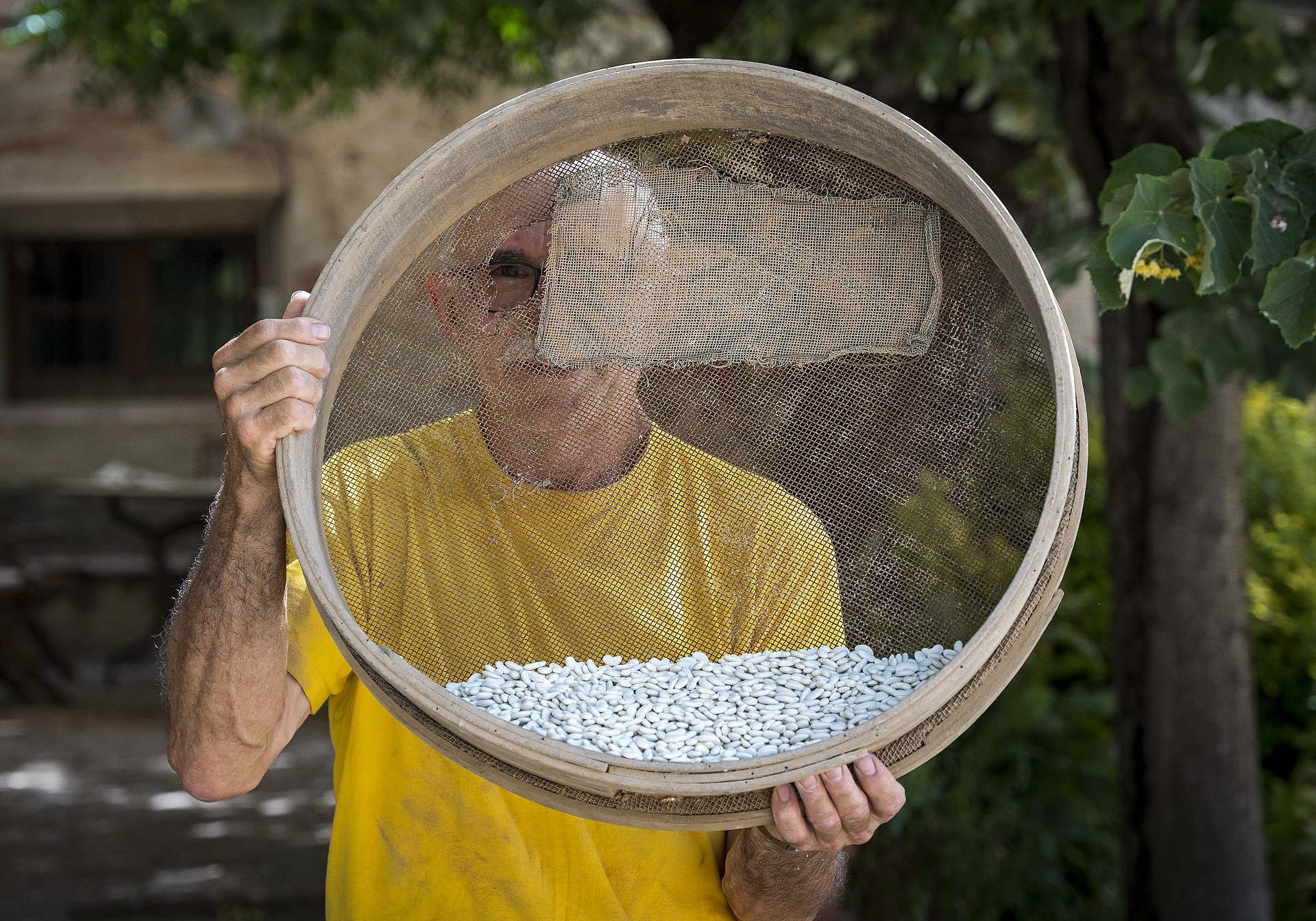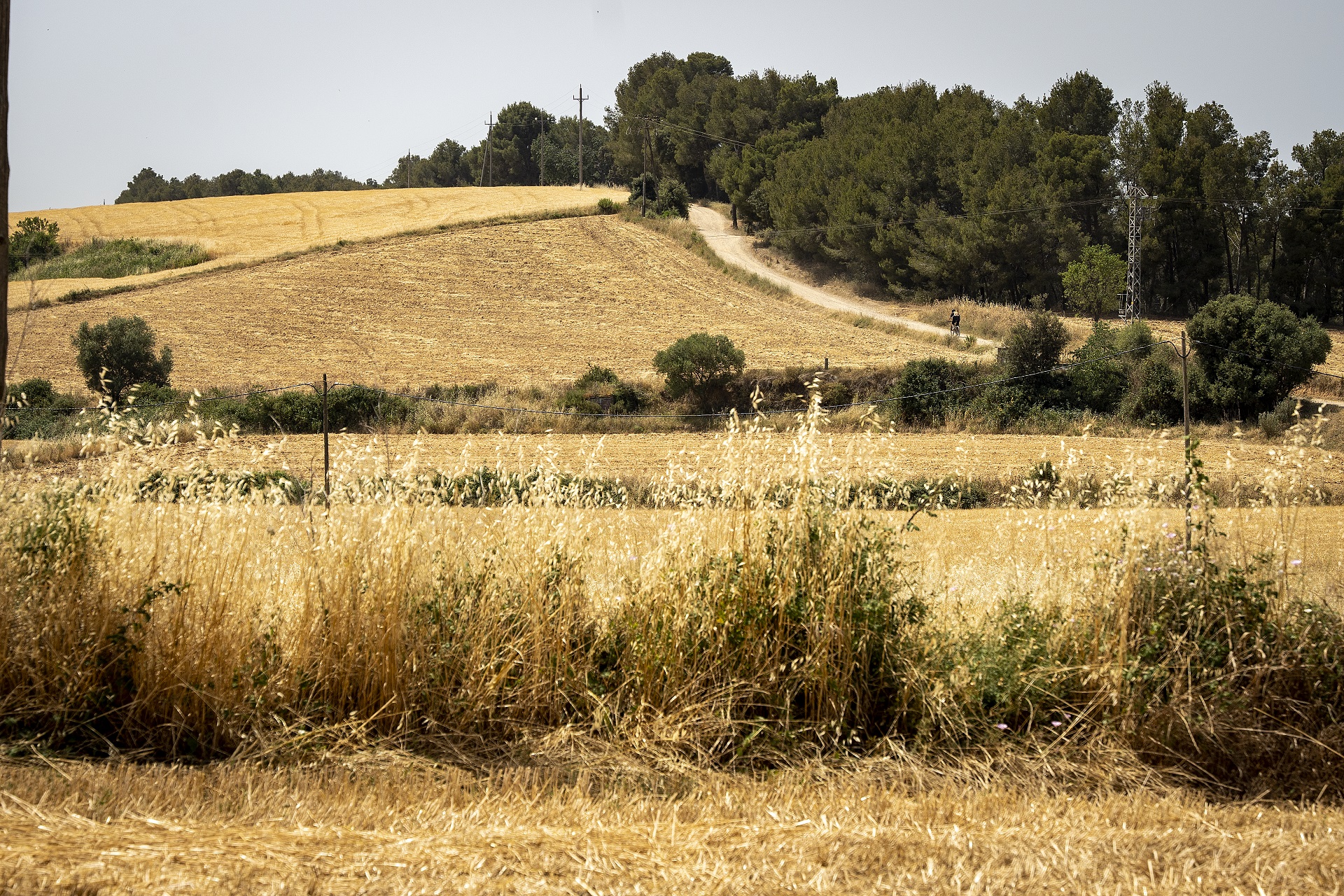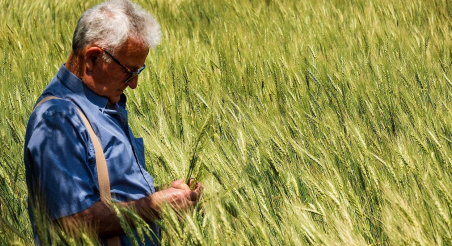Can Casamada has established itself as a prominent presence in the agricultural scene of Vallès Occidental, thanks above all to Ramon Casamada i Faus, known as "the father" of the family, an enthusiastic farmer who was strongly committed to local associations and to preserving the nature of the Vallès area. Casamada, who died in 2012, left a significant legacy and, more importantly, passed on his passion for the countryside to his offspring. Three of his sons – Ramon, Jordi and Joan – continue to work the land today. Two of the brothers live in the family farmhouse, along with their two sisters: Mireia and Rosa. To learn more about the project, we interviewed the eldest brother, Ramon Casamada Humet (Castellar del Vallès, 1955). Ramon lives with his wife in Castellar, but spends twelve hours a day at the farm, enjoying its peri-urban setting.
At Can Casamada, they grow grain and fodder crops, but the business stands out in particular for its major contribution to the creation of the Protected Designation of Origin seal of the Ganxet Bean, a legume which fills them with pride and which they sell in their farm shop. They like to point out that the ganxet white bean grown in their area has unique organoleptic features: a mild taste, good creaminess and a skin that goes almost unnoticed. They’ve been cultivating this legume for decades and have managed to master everything from cultivation techniques (they grow their beans vertically on a trellis to save water) to the mechanisation of certain stages of the process, not to mention cooking methods, which Ramon describes enthusiastically.
Today, they cultivate around 35 hectares of dry farmland and own around 70 hectares of forest which, according to Ramon, «provides misery and company» . This farmer always has a Catalan saying or expression on the tip of his tongue. As we will see throughout the interview, he likes to communicate directly and openly.
In addition to the agricultural side of things, they also run a livestock business with three hundred sows via the so-called integration model, some 1,500 fattening pigs and 160 calves.
Can Casamada currently maintains three families, but the agricultural tradition of the farmhouse goes back hundreds of years. It adopted the Casamada surname as far back as the 17th century.
What are the origins of the farmhouse?
The farmhouse dates back to 1300. For several generations it was associated with the surnames Morral and Casamada. It was not until the 17th century that a member of the family had enough power to put the Casamada surname first. This person took Josep and Morral as his first names, and Casamada as his surname. Moving on to my grandfather’s generation, we find that he lived in Montcada, while this place, Can Casamada, was occupied by tenant farmers. My grandfather had eight children, who became doctors, engineers, industrialists, etc. However, my father was attracted to the farming profession. The farmhouse was falling apart at that time, which was when my grandfather said: “Well, the farmhouse can go to my youngest son!” My dad moved in here and started farming. Now everyone complains about it!
Do you think they complain because there’s been a reappreciation of small-scale farming and the countryside? In your grandfather’s day, small-scale farmers were denied the social recognition they enjoy today. Salvi Safont, of the Can Salvi farmhouse in the Gallecs Rural Space, told us in an interview that he suffered a lot when he was young, that he’d be given dirty looks whenever he said he was a farmer.
There was a time when small-scale farmers were considered a waste of space. But now the worm has turned! I never suffered in that way because I was already heavily involved in social activities in Castellar del Vallès: I was a member of traditional dance groups (gypsy dance, stick dance), I danced at sardana gatherings... My wife’s a pastry chef, so the combination of a pastry chef and a small-scale farmer means we do just fine here!
Turning to your daily routine. What do you like to do most when you start your working day?
I leave the house and look at the sky, head off to work and never complain. That’s just the way I am. It’s like breastfeeding. You’re not going to stop breastfeeding your baby even if it starts raining, are you? You’ll just open your umbrella and get on with it. Well, it’s the same with this. I get on with the job I’ve chosen, without splitting hairs. I’m obviously faced with obstacles too, but this is the job I love, so I overcome them. We’ve got a rule in this house: we can spend five minutes doing all the moaning we want, but at minute six we have to start looking for the solution. There’s no use in complaining. We have the capacity and ingenuity to quickly envisage the solution to problems.
When we started growing beans, we went about it very ham-fistedly. Now, 30 years later, we’ve become so proficient at it that we no longer get stressed. Every year we ask ourselves how we might improve. If the tweak works, we’ll perfect it the following year. Ingenuity out in the fields enables us to turn problems around.
«We’ve got a rule in this house: we can spend five minutes doing all the moaning we want, but at minute six we have to start looking for the solution. There’s no use in complaining» Ramon Casamada
However, problems sometimes crop up. How do you deal with them?
I have the gift of being able to quickly change my mindset, and that’s what I do when I get home. If I’ve got problems, I ask myself: «Can I fix them now? No? They’re best left alone then.» I used to like reading the back page of the newspaper, which often featured interviews with psychologists and mental health coaches. I’d think to myself: «I already do everything they’re saying here. Ha, ha, ha!»
Having one’s head screwed on right is the best therapy for anyone. But stuff happens in farming! For instance, we lost 90% of our grain yield as a result of drought... We’ve lost 240 tons, which would have a sale value of roughly 50,000 euros, but we’ve had to pay for the machinery anyway. And to be able to sow this year, we’ve had to invest another 25,000 euros, although there’s no way of knowing whether next year’s harvest will be good or bad. What’s more, our pigs have been infected by the Rosalia strain of PRRS, which has reduced our income by 40%. You have to keep your head and remember to breathe; otherwise, you could go crazy.
Let’s move on to the bean, which you’re passionate about. The World Health Organization recommends adding more legumes to a healthy diet, but, generally speaking, the bean is a somewhat neglected crop. Why have you been focusing on it for a few decades now?
It all started because we were dedicated to producing silage fodder for a dairy, until one day we folded. At first we didn’t know what to do, but then we came up with the idea of growing beans. Dad had a friend who grew cucumbers using trellises, so we tried to do the same with beans. I admit I was reluctant to do it the first year. Ha, ha, ha! In fact, the trellis collapsed. But we had another go the following year, and a group from the university started doing some growing tests and helped us out. We learned things together, and we ended up getting enthusiastic about it! Nowadays I’m very knowledgeable about growing this bean, and I also like to cook and eat it. It gives me satisfaction!
«Nowadays I’m very knowledgeable about growing this bean, and I also like to cook and eat it. It gives me satisfaction!» Ramon Casamada
Since you started growing this bean, you’ve done a lot of work to perfect your cultivation techniques. How did you get to where you are now?
We’ve spent a lot of time selecting the pure seed. We started with this seed in 2002 and, with the help of the university, we did a lot of tests and tastings. Now, every five years we repeat the whole cycle, starting from scratch: from one grain we plant ten or twelve plants. We see which plant thrives the most and, once we’ve identified it, we take it to continue with that seed. The chemical composition of each bean is different! I know how much it costs us to produce it, I know the organoleptic result, how to cook it... I know all its secrets. What’s more, I’m a bit of a gourmet.
You were part of the group that promoted the creation of the Protected Designation of Origin (PDO) seal of the Ganxet Bean. Are you still involved?
We promoted the designation of origin seal to add value to the work of the small-scale farmers who produced the beans. But we soon encountered the problem that while olive oil can account for 100% of a farmer’s income, beans are a byproduct that only accounts for 10% of a dryland farmer’s turnover. And it hasn’t been successful because of the farmers themselves, since there are many who’ve refused to follow requirements such as selling their beans packaged and labelled, etc. When some of our forest land was destroyed by a gale, we had a few worrying months and I stopped going to the PDO meetings. For too long I’d been attending events, fairs, etc., without charging a cent for my time... The fact is that I used to certify my beans with the seal, but I got tired of it because I was actually selling the beans in our own farm shop. You can’t get more local than that! And I supply the restaurants personally. I certify the beans myself!
When you taste your bean cooked in restaurants, are you picky?
Yes. When a plate of beans arrives, just from their appearance, I know if they haven’t been cooked for long enough! Since I know the effort that’s required, when chefs don’t cook them properly, it’s the bean that looks bad. What I like is when people raise their eyebrows on tasting them! It’s not about eating an expensive food, but rather one that surprises you with its flavour. That’s what we’re aiming for, but without the collaboration of the chef it can’t be done. You have to visit the restaurants, and when they see you arrive they say: «Not today!» Ha, ha, ha!
«It’s not about eating an expensive food, but rather one that surprises you with its flavour» Ramon Casamada
Could you share your secrets for cooking ganxet beans properly?
First, you have to leave them to soak for an hour. Then you have to cook them for four hours. It’s best to just put them on the hob and leave them, forget about them! Don’t add salt, baking soda or anything else. Moreover, the heat should be at about 90-95 degrees, so that they’re not bouncing around in the pot.
Would you have liked to be a cook?
No, I don’t cook, you know? I’m a farmer! But I do like to eat and have an opinion about what I eat. Unfortunately for restaurateurs, when I start eating I concentrate and close my eyes. Sometimes, I ask them if the dish really contains what I’ve been told. Although I may be surprised by the appearance of the dish, I focus on how it tastes. And then, I tell them straight what I think of it!
What about being a food critic?
No. It’s small-scale farming all the way for me!
Do you think you have a good life?
I enjoy it. I haven’t travelled, but I’ve done what I’ve wanted to. I don’t complain about what I can’t do. I can’t do it, can I? So there’s no point complaining about it, is there? I think you have to invest your energy in what you can change.
«I think you have to invest your energy in what you can change» Ramon Casamada
How do you see the future of your agricultural and livestock activity? Could you tell us about a specific project that you’re currently working on?
One of next year’s projects is to re-sow. We’re currently planning the planting season, although not knowing what will happen with the drought is a worry. Getting the pond filled with water to irrigate crops is another headache.
With regard to the future of the sector, how do you see initiatives to promote generational renewal in small-scale farming? What advice would you give to encourage new generations to pursue this profession?
Neither me nor my brothers were encouraged by anyone. I think being a farmer is something you must have in your blood. When someone volunteers for something, no one tells them to volunteer, but rather it comes from within, doesn’t it? Well, being a small-scale farmer is the same! If you’re not born with this instinct, things won’t turn out well.
«We should have bottom-up projects, created out of necessity» Ramon Casamada
Do you have any direct requests for the powers that be?
When it comes to promoting generational change, I’d ask institutional leaders to focus on initiatives that lead to a real increase in the number of farmers. If they achieve this goal, hats off to them, because every day there are fewer farmers. Many initiatives are decided by the people at the top and they’ve been generously funded. For example, the Government of Catalonia promoted local sales, but it hasn’t worked. I think we should have bottom-up projects, created out of necessity. So what’s the major problem for agricultural producers? Logistics, as we saw during the pandemic. Refrigerated vehicles are expensive, so if the public authorities really want to help us, they should subsidise food transport. This might involve bearing the costs of the company that transports the produce, for example. But instead of this, we’re often asked to participate in show cooking events and the like, featuring producers and restaurateurs, which ignore the logistical challenges involved. These initiatives often overlook how farmers will transport their produce.
— BCN Smart Rural Editorial —




